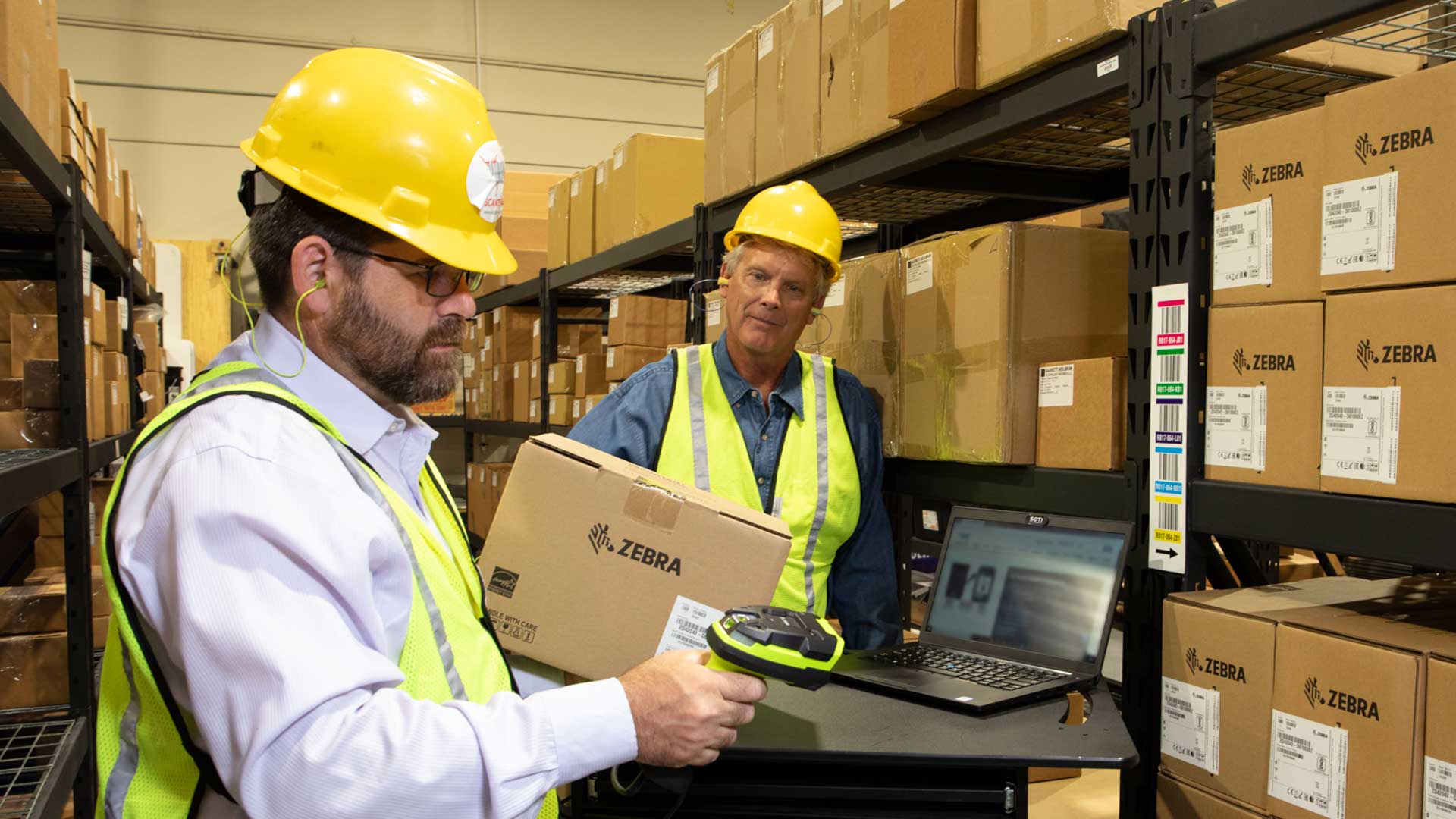

Finance
What Is Barcoding In Stocks
Published: January 17, 2024
Learn how barcoding in stocks can streamline your finance processes and improve inventory management. Discover the benefits of using barcodes in the finance industry.
(Many of the links in this article redirect to a specific reviewed product. Your purchase of these products through affiliate links helps to generate commission for LiveWell, at no extra cost. Learn more)
Table of Contents
- Introduction
- Definition of Barcoding in Stocks
- History of Barcoding in Stocks
- Benefits of Barcoding in Stocks
- Common Uses of Barcoding in Stocks
- Barcoding Technologies in Stock Management
- Implementation Process of Barcoding in Stocks
- Challenges and Limitations of Barcoding in Stocks
- Future Trends in Barcoding in Stocks
- Conclusion
Introduction
Imagine walking into a massive warehouse filled with thousands of products. How would you keep track of each item? How would you maintain inventory accuracy and streamline the order fulfillment process? This is where barcoding in stocks comes into play. Barcoding has revolutionized inventory management, providing businesses with a reliable and efficient way to track and manage their stock.
In simple terms, barcoding in stocks refers to the process of assigning unique codes to products or items using barcode labels. These labels consist of a series of parallel vertical lines that can be scanned by a barcode reader. Each barcode represents a specific product and contains encoded information, such as the product name, price, and other relevant details.
The use of barcoding in stocks has become increasingly popular across various industries, including retail, manufacturing, and logistics. It offers a range of benefits, from improving inventory accuracy to enhancing operational efficiency. In this article, we will explore the definition of barcoding in stocks, its history, benefits, common uses, technologies, implementation process, challenges, and future trends.
With the ever-growing complexity of stock management and the need for real-time data, barcoding has emerged as a fundamental tool for businesses to thrive in the competitive marketplace. So, let’s dive deeper into the world of barcoding in stocks and discover how this technology has transformed inventory management as we know it.
Definition of Barcoding in Stocks
Barcoding in stocks refers to the practice of assigning unique barcode labels to products or items in order to track and manage inventory efficiently. It is a systematic approach that allows businesses to automate and streamline stock management processes, from receiving goods to tracking their movement and ensuring accurate fulfillment.
A barcode is a visual representation of data in the form of a series of parallel vertical lines of varying widths. Each barcode is unique and contains encoded information about the product it represents, such as the item’s name, price, serial number, or any other relevant details. These barcodes can be scanned by a barcode reader, which converts the pattern into digital information that can be processed by a computerized system.
Barcoding in stocks provides businesses with several advantages. Firstly, it eliminates the need for manual data entry, reducing human errors and saving valuable time. With a simple scan, information about the product can be instantly retrieved, including its current stock level, location, and even expiration date.
Moreover, barcoding allows for real-time inventory tracking, enabling businesses to have up-to-date information on stock levels and prevent stockouts or overstocking. This not only helps in optimizing inventory levels but also improves customer satisfaction by ensuring accurate and timely order fulfillment.
The barcode labels used in stock management can vary in format, depending on the specific requirements of the business. The most commonly used barcode formats include Universal Product Code (UPC), European Article Number (EAN), and Code 39. These formats adhere to international standards, making barcoding in stocks universally applicable.
Overall, barcoding in stocks plays a pivotal role in modern inventory management by automating processes, improving accuracy, and enhancing operational efficiency. It has become an indispensable tool for businesses of all sizes, providing them with a powerful means to handle and control their stock effectively.
History of Barcoding in Stocks
The history of barcoding in stocks dates back to the early 1970s when the need for a standardized, efficient method of inventory management became evident. The concept of using barcode technology to track and manage stock was pioneered by Norman Joseph Woodland and Bernard Silver.
In 1949, Woodland, a graduate student at Drexel Institute of Technology, along with his friend Silver, developed the initial idea for barcode technology. However, it took them more than two decades to finalize and commercialize their invention.
In 1973, the first-ever barcode was scanned at a supermarket in Troy, Ohio. The barcode, a circular symbol with lines of varying heights, represented the number “0” and marked a significant milestone in the history of barcoding. This event laid the foundation for the adoption of barcoding technology in various industries, including stock management.
Over the years, the adoption of barcoding in stocks gained momentum as businesses recognized its potential to improve efficiency and accuracy in inventory management. The advent of computerized systems and barcode readers made it easier to scan and process barcoded information, further propelling the widespread adoption of this technology.
In the 1980s, barcode symbologies such as the Universal Product Code (UPC) and the European Article Number (EAN) were developed, setting the standard for barcode formats. These standardized formats ensured compatibility across different industries and enabled accurate tracking and control of stock at a global scale.
With advancements in technology, barcoding systems have become more sophisticated and integrated. Barcode readers have evolved from handheld scanners to more advanced devices that can capture barcodes in various orientations and even from a distance. Additionally, the integration of barcode technology with inventory management software has made it easier to synchronize stock data, track inventory movements, and generate detailed reports.
Today, barcoding in stocks is an integral part of inventory management systems across industries. It has become a cornerstone technology, enabling businesses to effectively monitor their stock, streamline operations, reduce costs, and enhance customer satisfaction.
The ongoing advancements in barcoding technology, such as the adoption of two-dimensional barcodes and the development of mobile barcode scanning solutions, continue to reshape the way stock management is carried out. As businesses strive for greater efficiency and accuracy in their operations, barcoding in stocks remains a crucial tool for achieving these goals.
Benefits of Barcoding in Stocks
Barcoding in stocks offers numerous benefits to businesses, irrespective of their size or industry. These advantages contribute to improved efficiency, accuracy, and cost-effectiveness in stock management processes. Let’s explore some of the key benefits of incorporating barcoding technology:
- Enhanced Inventory Accuracy: Barcoding eliminates the need for manual data entry and minimizes human errors, resulting in improved inventory accuracy. By scanning barcodes, businesses can easily update stock levels, track item locations, and monitor expiration dates, ensuring precise inventory control.
- Increased Operational Efficiency: Barcode scanners can read and process information quickly, making stock management tasks more efficient. With barcoding, businesses can streamline processes such as stock receiving, picking, and stocktaking, reducing the time and effort required for these tasks.
- Real-time Stock Tracking: Barcoding enables businesses to track stock in real-time, providing up-to-date data on stock levels and locations. This feature helps prevent stockouts and overstocking, enabling businesses to optimize inventory levels and fulfill customer orders more efficiently.
- Improved Order Accuracy: Barcode scanning eliminates manual picking errors, improving the accuracy of order fulfillment. By scanning items, businesses can ensure that the right products are picked and shipped, reducing returns and customer dissatisfaction due to incorrect deliveries.
- Cost Savings: Barcoding reduces the time and effort spent on manual stock management, leading to cost savings in labor. The automation of stock-related processes, coupled with improved accuracy, minimizes wastage, loss, and carrying costs associated with ineffective inventory control practices.
- Streamlined Auditing and Reporting: Barcodes provide an efficient way to track stock movements, making audits and reporting easier and more accurate. Barcode technology allows businesses to generate comprehensive reports on inventory counts, stock valuation, and other essential metrics, facilitating better decision-making.
- Integration with Inventory Management Systems: Barcoding seamlessly integrates with inventory management software, enabling real-time synchronization of stock data. This integration enhances data visibility and accessibility, allowing businesses to have a centralized view of their stock and make informed decisions based on accurate information.
In summary, barcoding in stocks offers a range of benefits that significantly improve inventory management processes. From enhanced accuracy and efficiency to cost savings and seamless integration, barcoding technology empowers businesses to take control of their stock and optimize their operations for better performance and customer satisfaction.
Common Uses of Barcoding in Stocks
Barcoding in stocks finds application in various industries and is utilized for a wide range of stock management tasks. Let’s explore some of the common uses of barcoding technology in stock management:
- Inventory Tracking: Barcoding is primarily used for tracking and monitoring inventory levels accurately. Every product is assigned a unique barcode that contains information about the item. By scanning barcodes during receiving, picking, or stocktaking processes, businesses can easily update stock levels and keep track of item movements in real-time.
- Order Fulfillment: Barcodes play a crucial role in ensuring accurate and efficient order fulfillment. When an order is received, barcode scanners are used to scan the products being picked. The system verifies the scanned items against the order, reducing picking errors and improving order accuracy.
- Product Authentication: Barcodes can be used for product authentication and anti-counterfeiting measures. Unique barcodes can be assigned to each item, making it easier to verify its authenticity. This is particularly important in industries like pharmaceuticals and luxury goods, where counterfeit products can have serious consequences.
- Asset Tracking: Barcoding is also utilized for tracking and managing assets within a business. Whether it’s equipment, machinery, or tools, barcodes can be assigned to these assets to keep track of their location, maintenance schedules, and usage history. This helps businesses prevent loss or misplacement of assets and improves overall asset management.
- Quality Control: Barcoding plays a role in quality control processes by enabling businesses to track and trace products throughout the manufacturing or supply chain. Barcodes can be scanned at various production stages, allowing for easy identification of defects and facilitating recalls if necessary. This ensures that products meet quality standards and comply with regulations.
- Expiration Date Management: In industries such as food or pharmaceuticals, proper management of expiration dates is critical. Barcoding technology helps businesses track and manage the shelf life of products. By scanning barcodes, businesses can identify products nearing expiration, reducing the risk of selling expired goods.
- Batch and Lot Tracking: Barcodes enable effective batch and lot tracking, essential for industries dealing with perishable or regulated goods. Each batch or lot can be assigned a unique barcode, allowing businesses to trace the specific items associated with a particular production or shipment. In the event of product recalls or quality issues, batch and lot tracking helps identify and isolate affected items quickly.
These are just a few of the many common uses of barcoding in stocks. The versatility of barcoding technology makes it applicable to a wide range of stock management tasks, helping businesses optimize their inventory control, improve operational efficiency, and enhance overall supply chain management.
Barcoding Technologies in Stock Management
Barcoding technologies have evolved over time to offer various options for businesses to efficiently manage their stock. These technologies not only simplify the process of barcode generation but also enhance the capabilities of barcode scanning and data integration. Let’s explore some of the key barcoding technologies used in stock management:
- Linear Barcodes: Linear barcodes, such as the Universal Product Code (UPC) and Code 39, are the traditional form of barcodes consisting of a series of parallel lines of varying widths. They are widely used for retail and stock management purposes. These barcodes can store a limited amount of information and are easily scanned by laser-based barcode readers.
- 2D Barcodes: Two-dimensional (2D) barcodes, such as QR codes and Data Matrix codes, offer increased data storage capacity compared to linear barcodes. They can store alphanumeric information, website links, and even images. 2D barcodes can be scanned by specialized 2D barcode scanners or smartphone apps, making them versatile and widely applicable in stock management.
- Mobile Scanning: With the widespread use of smartphones, mobile barcode scanning has become increasingly popular. Mobile applications, equipped with built-in cameras, can scan barcodes using the device’s camera and process the encoded information. This allows for greater mobility and flexibility in stock management, as barcode scanning can be performed using readily available smartphones or tablets.
- RFID Technology: Radio Frequency Identification (RFID) technology offers an advanced alternative to traditional barcoding. RFID tags contain a microchip and an antenna that can transmit data wirelessly to RFID readers. This technology enables automatic and contactless scanning of items, making it faster and more efficient. RFID is commonly used for tracking high-value assets or in industries where scanning large volumes of items is required.
- Integration with Inventory Management Software: Barcoding technologies in stock management are often integrated with inventory management software systems. This integration allows for seamless data synchronization between barcode scanners and the central database, providing real-time visibility of stock levels, movements, and other relevant information. Integration streamlines stock management processes, minimizes errors, and facilitates accurate reporting and analysis.
Regardless of the specific barcoding technology used, the primary goal remains the same: to simplify stock management processes, improve accuracy, and enhance efficiency. Businesses can choose the barcoding technology that best suits their needs and budget, ensuring smooth and effective stock management operations.
Implementation Process of Barcoding in Stocks
The implementation process of barcoding in stocks involves several key steps to ensure a successful transition to barcode-based stock management. Let’s explore the typical implementation process:
- Assessment and Planning: The first step is to assess the existing stock management processes and determine the specific requirements for implementing barcoding. This involves evaluating the inventory control system, identifying areas for improvement, and planning the scope and objectives of the implementation.
- Barcode Design and Generation: Once the requirements are determined, the next step is to design and generate barcode labels. This involves selecting the appropriate barcode format, assigning unique codes to each product, and printing barcode labels using barcode label printers or outsourcing the task to a professional printing service.
- Barcode Scanners and Hardware Setup: Businesses need to invest in barcode scanners and related hardware that best fit their needs. This may include handheld barcode scanners, fixed scanners at key locations, or mobile scanning devices. The hardware setup should be designed to ensure efficient scanning and compatibility with the inventory management system.
- Software Integration: Integrating the barcode scanning system with the inventory management software is a critical step. This involves configuring the software to recognize barcode data and establishing a connection between the barcode scanners and the central database. The integration ensures real-time synchronization of stock data and enables accurate inventory tracking and reporting.
- Employee Training: Proper training of employees is essential to ensure the smooth adoption of barcoding in stocks. Employees should be trained on how to use barcode scanners, scan and process barcodes accurately, and understand the importance of barcode data in stock management. Ongoing training and support should be provided to address any questions or challenges that may arise.
- Pilot Testing: Before fully implementing barcoding across the entire stock management system, conducting pilot testing is recommended. Select a small subset of products or a specific area of the warehouse to test the barcode scanning process. This allows for troubleshooting and fine-tuning any issues or inefficiencies before scaling up the implementation.
- Monitoring and Evaluation: Once barcoding is implemented, continuous monitoring and evaluation are crucial to ensure its effectiveness and identify areas for improvement. Regularly review data accuracy, scanning efficiency, and any challenges faced by staff or systems. This feedback loop will help refine and optimize the barcoding process over time.
Each business may have specific requirements and variations in their implementation process, but these steps provide a general framework for successfully implementing barcoding in stocks. By following these steps and adapting them to suit their specific needs, businesses can streamline stock management processes and achieve greater accuracy and efficiency.
Challenges and Limitations of Barcoding in Stocks
While barcoding in stocks offers numerous benefits, there are also certain challenges and limitations to be aware of. Understanding these challenges can help businesses address them effectively and maximize the benefits of barcoding technology. Let’s explore some common challenges and limitations:
- Implementation Costs: Implementing a barcoding system requires an investment in barcode scanners, printers, labels, and software integration. For small businesses with limited resources, the upfront costs of implementing barcoding technology can be a challenge.
- Barcode Label Durability: Barcode labels can wear off or become damaged due to harsh environments, high temperatures, or exposure to chemicals. This can impact the readability of barcodes and require regular label maintenance or replacement.
- Dependence on Scanning Equipment: The effectiveness of barcoding in stocks relies heavily on the performance and reliability of barcode scanners. If scanners malfunction or have limited battery life, it can disrupt stock management processes and lead to delays.
- Barcode Readability: Barcodes may not always be scanned successfully due to poor label printing, smudges, or damage. This can result in inaccurate stock data, requiring manual intervention and potential errors in stock management.
- Barcode Label Standardization: Different industries may have their own labeling requirements and barcode standards. Adhering to these standards and ensuring compatibility across the supply chain can be a challenge, especially when working with multiple suppliers or retailers.
- Training and Workforce Adoption: Training employees on how to use barcode scanners and incorporating barcode scanning into daily operations may require time and effort. Resistance to change or lack of proper training can hinder the successful adoption of barcoding technology.
- Infrastructure and Connectivity: Barcoding systems may require a robust IT infrastructure to support seamless integration with inventory management software. In areas with limited connectivity or outdated systems, ensuring reliable data transmission between barcode scanners and the central database can be challenging.
- Product Specifics: Some products, such as small or irregularly shaped items, may present challenges in barcode placement or readability. Ensuring the right barcode label placement to ensure easy scanning for every item in the stock can be a consideration businesses need to address.
Despite these challenges and limitations, businesses can overcome them with careful planning, regular maintenance, and continuous training. By addressing these challenges proactively, businesses can leverage barcoding technology effectively to improve stock management practices, streamline operations, and enhance overall efficiency.
Future Trends in Barcoding in Stocks
Barcoding in stocks has come a long way since its inception, and the technology continues to evolve to meet the ever-changing demands of stock management. Several exciting trends are shaping the future of barcoding in stocks. Let’s explore some of these trends:
- Mobile Barcode Scanning: The widespread use of smartphones opens up new possibilities for mobile barcode scanning. Mobile applications with built-in barcode scanning capabilities allow businesses to leverage existing devices for stock management. This trend offers increased flexibility, ease of use, and improved accessibility for barcode scanning on the go.
- Cloud-based Solutions: Cloud computing has revolutionized the way businesses store and access data. Barcoding in stocks is no exception to this trend. Cloud-based inventory management systems can provide real-time synchronization of stock data, seamless integration with barcode scanners, and remote access to stock information from anywhere. This trend allows for enhanced collaboration, scalability, and data security.
- Internet of Things (IoT) Integration: The integration of barcoding technology with the Internet of Things (IoT) opens up exciting possibilities in stock management. IoT-enabled barcode scanners and sensors can provide real-time data on stock levels, temperature, humidity, and other environmental conditions. This trend allows for more accurate monitoring, proactive inventory management, and increased automation in stock-related processes.
- Artificial Intelligence (AI) Integration: The integration of AI technology with barcoding in stocks can enhance data analysis and decision-making capabilities. AI algorithms can analyze large volumes of barcode data to identify trends, optimize stock replenishment, and provide valuable insights for inventory management. This trend enables businesses to make data-driven decisions that result in improved stock control and operational efficiency.
- Blockchain Technology: Blockchain technology offers enhanced security and traceability in stock management. By incorporating barcoding with blockchain, businesses can ensure transparent and immutable records of stock movements and transactions. This trend provides greater trust, accountability, and efficiency in supply chain management, particularly in industries that require stringent compliance and product traceability.
- Automated Barcode Verification: Advancements in barcode scanning technologies allow for automated barcode verification. This includes the ability to validate barcode readability, check for duplicate or invalid barcodes, and perform quality control checks during stock receiving or picking processes. Automated barcode verification ensures higher accuracy, reduces errors, and minimizes manual interventions.
- Enhanced Label Durability: Innovations in label materials and printing technologies are improving the durability of barcode labels. Weather-resistant, tear-resistant, and tamper-evident barcode labels can withstand harsh environments and reduce the need for frequent label replacements. This trend improves barcode readability, reduces maintenance efforts, and enhances stock management efficiency.
These emerging trends showcase the potential for barcoding in stocks to further revolutionize inventory management. Businesses that embrace these trends can gain a competitive edge by leveraging advanced technologies to optimize their stock control, improve operational efficiency, and deliver enhanced customer experiences.
Conclusion
Barcoding in stocks has transformed inventory management, offering businesses a reliable and efficient way to track and manage their stock. The use of barcodes provides numerous benefits, including enhanced inventory accuracy, increased operational efficiency, real-time stock tracking, improved order accuracy, cost savings, streamlined auditing and reporting, and seamless integration with inventory management systems.
Throughout its history, barcoding technology has evolved, with advancements such as 2D barcodes, mobile scanning, RFID technology, and integration with inventory management software. These technologies have improved the capabilities of barcode systems, making them more versatile and adaptable to different stock management requirements.
However, there are also challenges and limitations to be considered, such as implementation costs, barcode label durability, dependence on scanning equipment, and barcode readability issues. Businesses need to address these challenges through careful planning, maintenance, and proper training to maximize the benefits of barcoding technology.
The future trends in barcoding in stocks are promising, with mobile scanning, cloud-based solutions, IoT integration, AI integration, blockchain technology, automated barcode verification, and enhanced label durability shaping the future of inventory management. These trends offer increased flexibility, accessibility, data analysis capabilities, security, and automation, enabling businesses to optimize their stock control and improve operational efficiency.
In conclusion, barcoding in stocks has revolutionized the way businesses manage their inventory. The adoption of barcode technology allows for accurate tracking, efficient stock management, and improved customer satisfaction. By embracing emerging trends and overcoming challenges, businesses can leverage the power of barcoding technology to stay competitive in the ever-evolving world of stock management.














